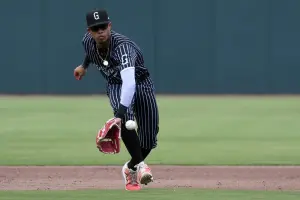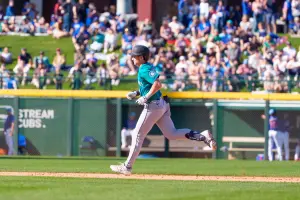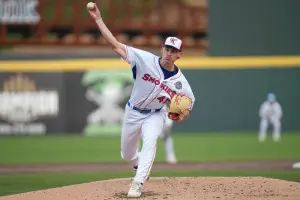
(*) MINORS: The Eyes have it—Kolby Allard & Chris Paddack
Pitching prospects are the most valuable commodity in baseball. Case in point, the Atlanta Braves. Leading up to this year's draft, most observers believed the Braves would take an outfielder with the third pick of the draft. Instead, the Braves selected high school pitcher Ian Anderson. Drafting Anderson saved money and enabled Atlanta to go after more high caliber pitching with the 40th and 44th selections. This strategy disappointed most Braves fans. Why pick a pitcher when the only legitimate outfield prospect is Ronald Acuna (Scouting Report) in Single-A? Well, finding cost controlled Major League pitching is a difficult proposition for Major League clubs. It's equally hard for fantasy owners too. Let's explore two cost controlled pitching options in Single-A, Braves prospect Kolby Allard and Marlins prospect Chris Paddack.
In the hunt? Let BaseballHQ.com help you snag the title. Unlock all of our insights like these for the rest of the season: Subscribe to BaseballHQ.com.
Kolby Allard (LHP, ATL)
#2 Braves prospect (Pre-season)
Date Seen: 06/18/16
If there is one prospect BaseballHQ.com readers and staff members connect me with, it is Braves prospect Kolby Allard. Last offseason, the BaseballHQ.com Minors team assigned me the task of ranking and evaluating the Braves farm system for our Organization Report and our player profiles in the Minor League Baseball Analyst. Relying on the word of a trusted source, I rated Allard a 10D in the book. For those unfamiliar with the MLBA ranking system, a 10D grade is a prospect with a 30% chance of reaching a Hall of Fame ceiling. To say I was bullish projecting Allard's upside would be an understatement. It made getting a first look at the left-handed pitcher all more exciting.
Recovery from off-season back surgery pushed back Kolby Allard's 2016 debut two months. When he finally debuted, he struggled mightily. Allard gave up thirteen hits, four walks and eleven earned runs in his first two starts. Entering his June 18 start against Greensboro, Allard sported a 14.14 ERA over seven innings. I did not know what to expect from the 18-year-old left-hander.
Allard was fantastic over 5 innings. He gave up 3 singles and didn't allow an earned run or walk to a Greensboro team that put the screws to him six days prior. On the strength of his fastball, Allard dominated a Greensboro's lineup that included Marlins 1B prospect Josh Naylor.
At 6'1'', 180 lbs, Allard employs a controlled, 3/4s delivery. The delivery creates a good bit of deception. Notice how Allard turns his back as he gathers at the balance point. He is able to hide the ball within his frame, giving hitters less time to react. Sitting 89-92, Allard's fastball does a remarkable job changing eye levels, setting up hitters for his curveball. In a sequence to Angel Reyes (2nd batter in video package), Allard commands two low 90s fastballs on the lower right quadrant of the plate. With a 0-2 pitch, Allard tries to get Reyes to chase up and away on another fastball. Reyes lays off but Allard comes back with a devastating curveball in that Reyes swings at in the dirt. This sort of sequencing shows maturity beyond his years. Having that devastating breaking ball to rely on helps, too.
Let's revisit the curveball Allard used to retire Reyes. Reyes could have been a 10-year MLB vet and he'd struggle with that pitch. Tightly wound, Allard's 12-to-6 curve is potentially the best left-handed hook I've scouted. It compares favorably to another left-handed pitcher I scouted, Angels pitcher Tyler Skaggs. While Skaggs has battled arm trouble and fastball command in his short major league career, the excellence of his curveball has never been doubted. Even though Skaggs was further along in development than Allard is now, Allard's ability to sequence pitches and command his fastball gives him a better chance than Skaggs has of ever realizing the plus-plus potential of his curve.
Allard's third pitch was not a focal point to Allard's game plan on in this start. Used once, my scouting report on Allard is incomplete. However, the one 84-mph change-up did mimic his fastball but missed by a lot.
Even without evaluating the change-up, Allard is a top-flight pitching prospect. Having scouted the Sally for seven seasons, no other left-handed pitcher compares to Kolby Allard's raw talent and advanced pitchability. Still, the road to the majors will not be without speed bumps. While I highlighted a sequence where Allard was near-perfect, Allard still experiences the same growing pains all young pitchers deal with, like inconsistency commanding and finishing pitches. In fantasy, Allard is several years away from making an impact. However, the premium on top flight pitching makes Allard a great stash and follow pickup.
Chris Paddack (RHP, MIA)
Unranked Marlins prospect (Pre-season)
Date Seen: 06/18/16
In seven years of scouting the South Atlantic League, I haven't published a single report on a Greensboro Grasshopper prospect. Either I miss their top pitching prospect's turn in the rotation (Jose Fernandez, Tyler Kolek), the team lacks prospects my audience wants to read about (2014 Greensboro team) or I go on vacation when their big prospect passes through Rome (Christian Yelich).
Traveling to Rome to scout the aforementioned Kolby Allard, I had an opportunity to put eyes on Greensboro, specifically first baseman Josh Naylor. What I didn't expect was an unknown Marlins pitching prospect flashing three potential plus pitches. Let's meet Marlins prospect Chris Paddack.
The Marlins drafted Chris Paddack in the 8th round of the 2015 draft. A high school hurler, Miami signed Paddack to a $400,000 bonus, twice the recommended value for the selection. Debuting professionally with Miami's GCL affiliate last season, the right-hander performed well over 45.1 innings. He allowed less than a baserunner an inning, striking out 39 and only walking 7 batters. Projected to open with Miami's NYPL affiliate Batavia, the Marlins shipped Paddack to Greensboro instead. Making his first start on 5/25, the 20-year-old has dominated South Atlantic League hitters, averaging 15 strike outs per nine innings and an astronomical 39:2 K:BB ratio. Paddack ended the first half with a bang. Over his last 10 innings, Paddack allowed no hits or runs, gave up one walk and collected nineteen strikeouts. How has this virtually unknown prospect quietly established himself as the Marlins top pitching prospect?
Few pitching prospects have Paddack's physical upside. Listed 6'4'', 195 lbs, he still has room to grow, especially between his shoulder blades and his lower half. Added strength should help his fastball gain additional velocity.
Paddack has a repeatable delivery. Gathering at the balance point, he stays tall and falls, driving towards the catcher's target. Downward plane created by his delivery helps his two best pitches play up.
A two-seam fastball is Paddack's workhorse pitch. Always around the strike zone, he overpowers hitters with 90-93 mph heat and sudden late movement. Horizontally, the pitch presents with classic two-seam arm-side movement. Vertically, his fastball has a mind of it's own. When working in the upper quadrant of the zone, the pitch will shoot upward. In the lower half of the zone, it exhibits traditional two-seam drop. His fastball reminds me of one thrown by former major league pitcher John Maine. Maine would overpower hitters with his mid-90s, late-moving fastballs.
Unlike Maine, who relied on the fastball as his only consistent out pitch, Paddack has a change-up capable of eliciting swings and misses. Creating solid discrepancy off the velocity of his fastball, his mid-80s change-up drops out of the zone an instant before reaching the plate. There isn't a notable tell in his delivery either. It's nearly impossible to hit his change-up, yet alone square it up.
Paddack also throws a 12-6 curveball that comes in at 74-75 mph. While he achieved above-average break on it, Paddack wrapped his wrist to achieve the movement. Wrist-wrapping is a common practice with young pitching. It is usually exposed in the upper minors. Watching video from last season, Paddack didn't feature a curve. Rather, he threw a slider. Likely, the curve is a new pitch and rotation is something mastered through repetition. Paddack's arm slot is ideal to throw a curve from. The wrist wrap usually works itself out as well.
Chris Paddack may be the best prospect in the Marlins farm system. His five-start domination of the South Atlantic League is not a mirage. The foundation is there for Paddack to become a front-line starter, especially if he adds strength for additional velocity and transforms his breaking ball into a viable 3rd pitch.
No one else is talking about Chris Paddack (I checked). Others see domination over five starts and think, "Small sample size." Even if he's far away from contributing, Paddack will be a valuable asset come this offseason. It's time to get in on this prospect before the hype begins.








